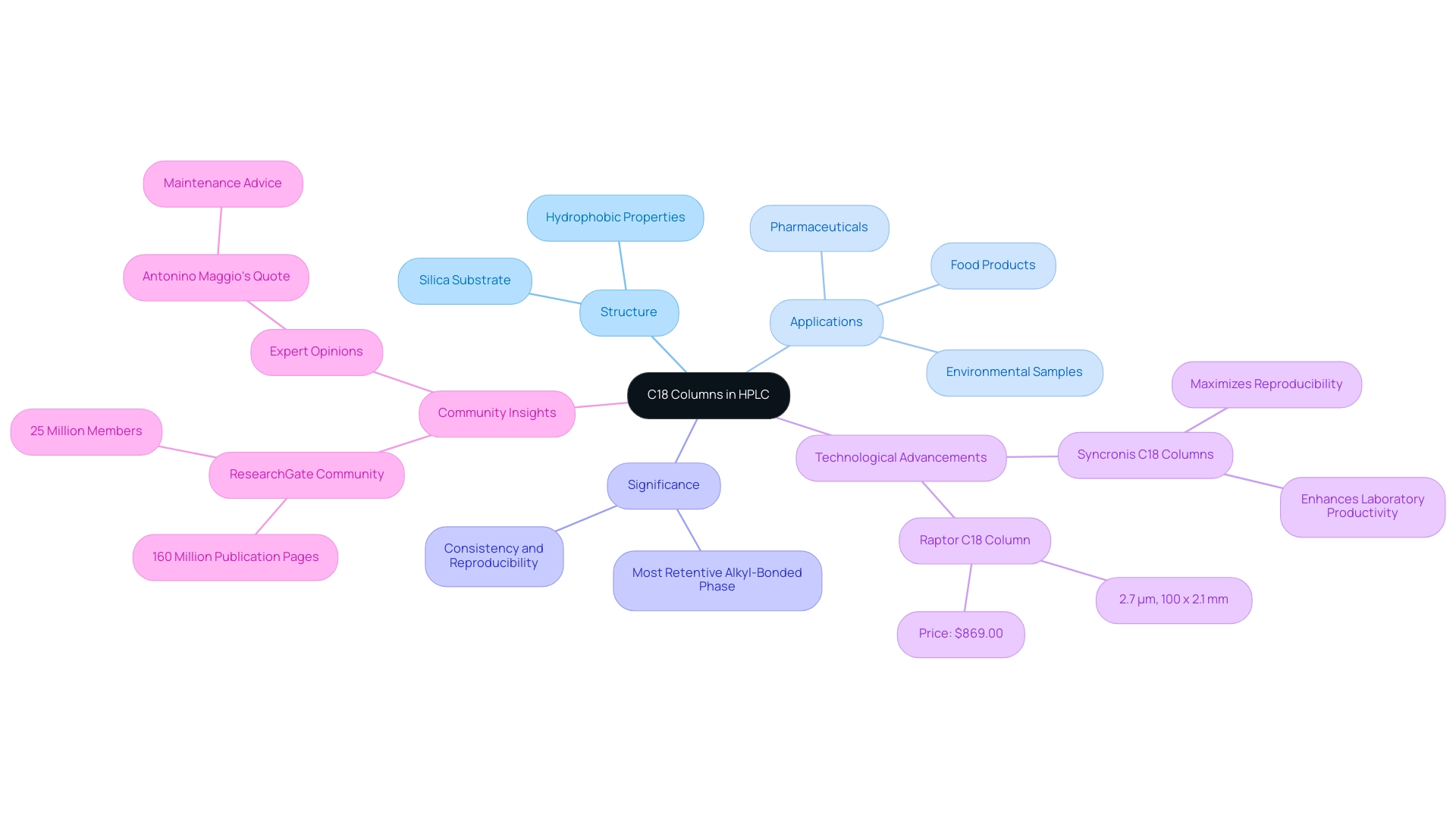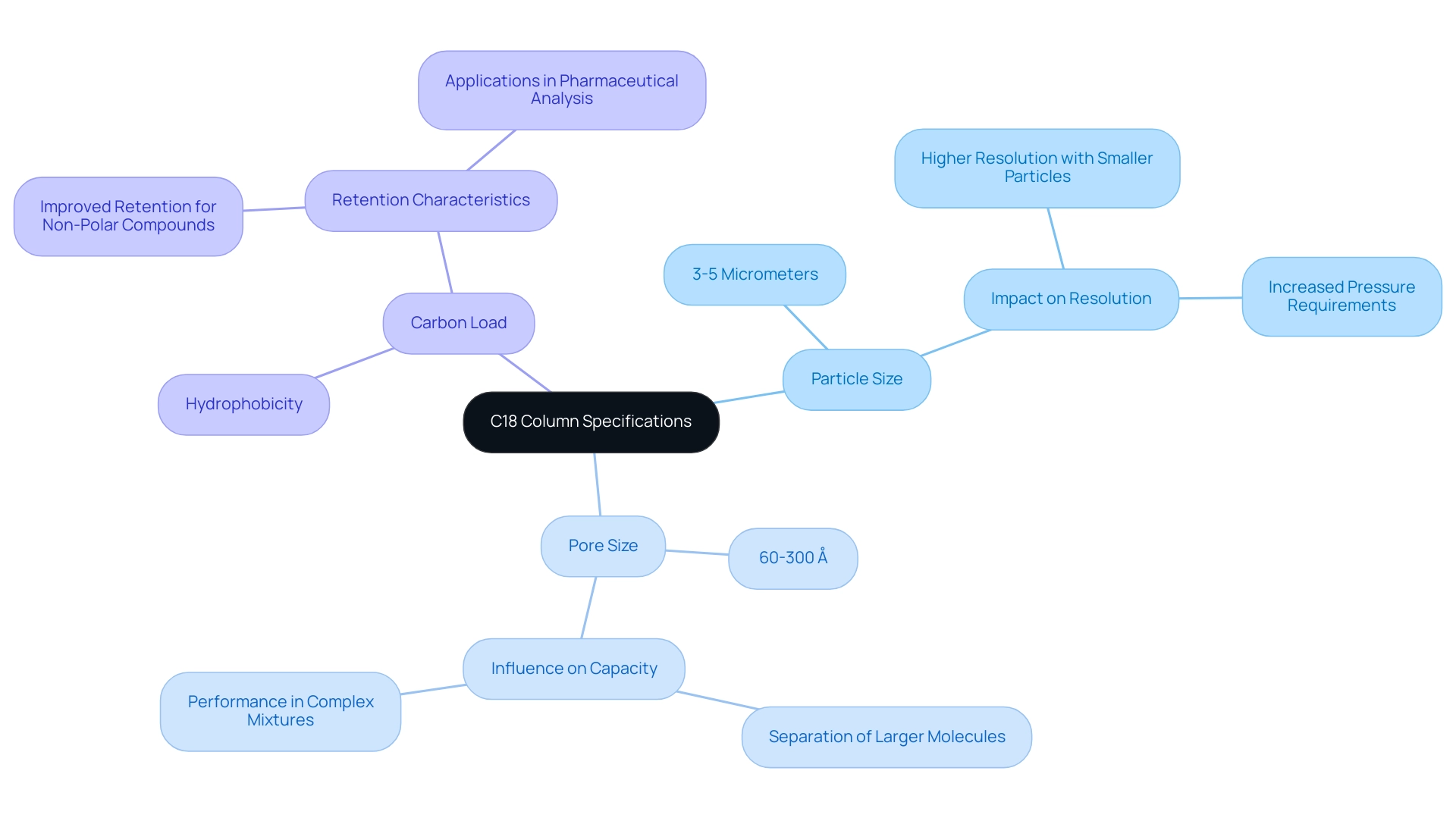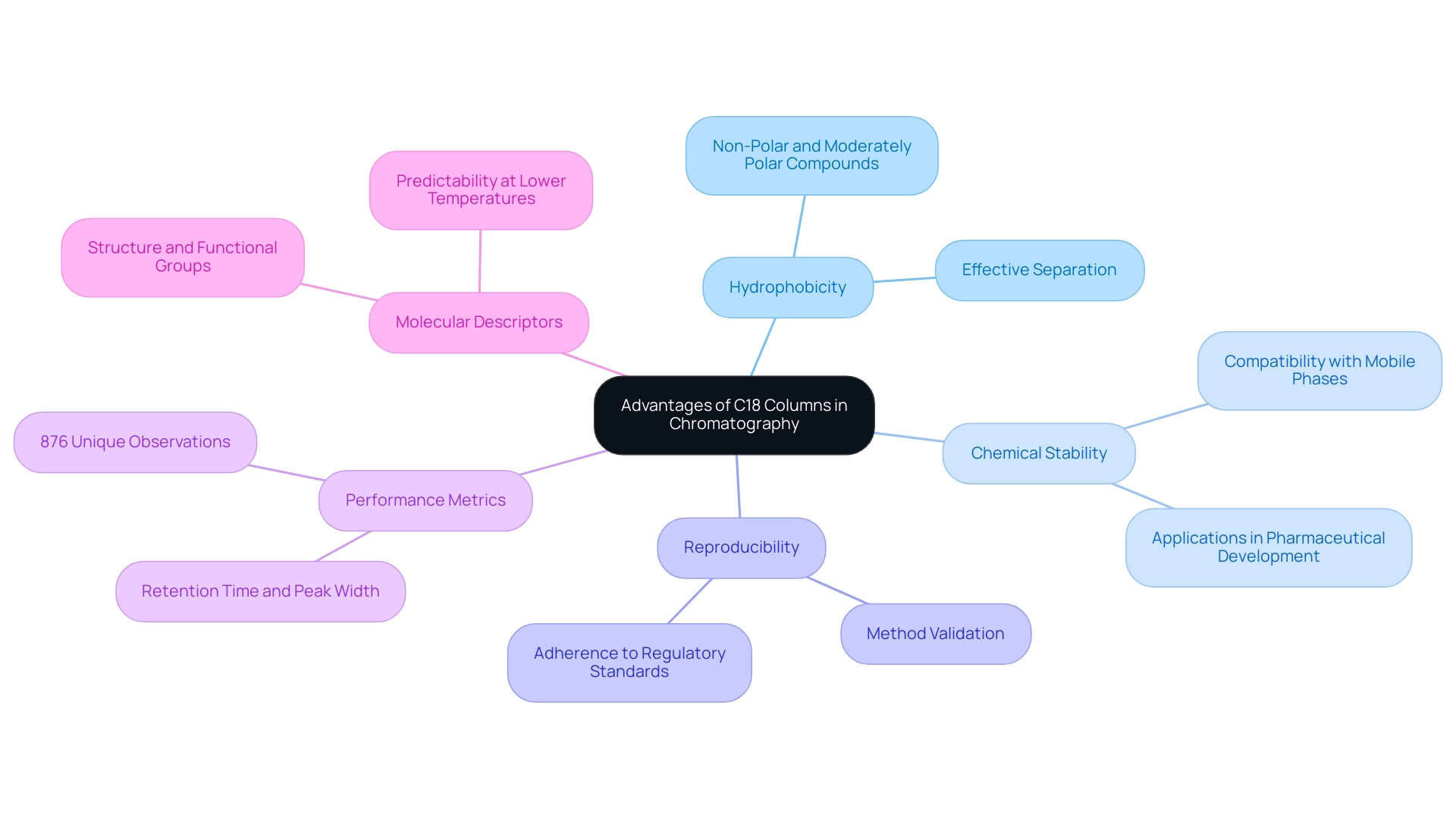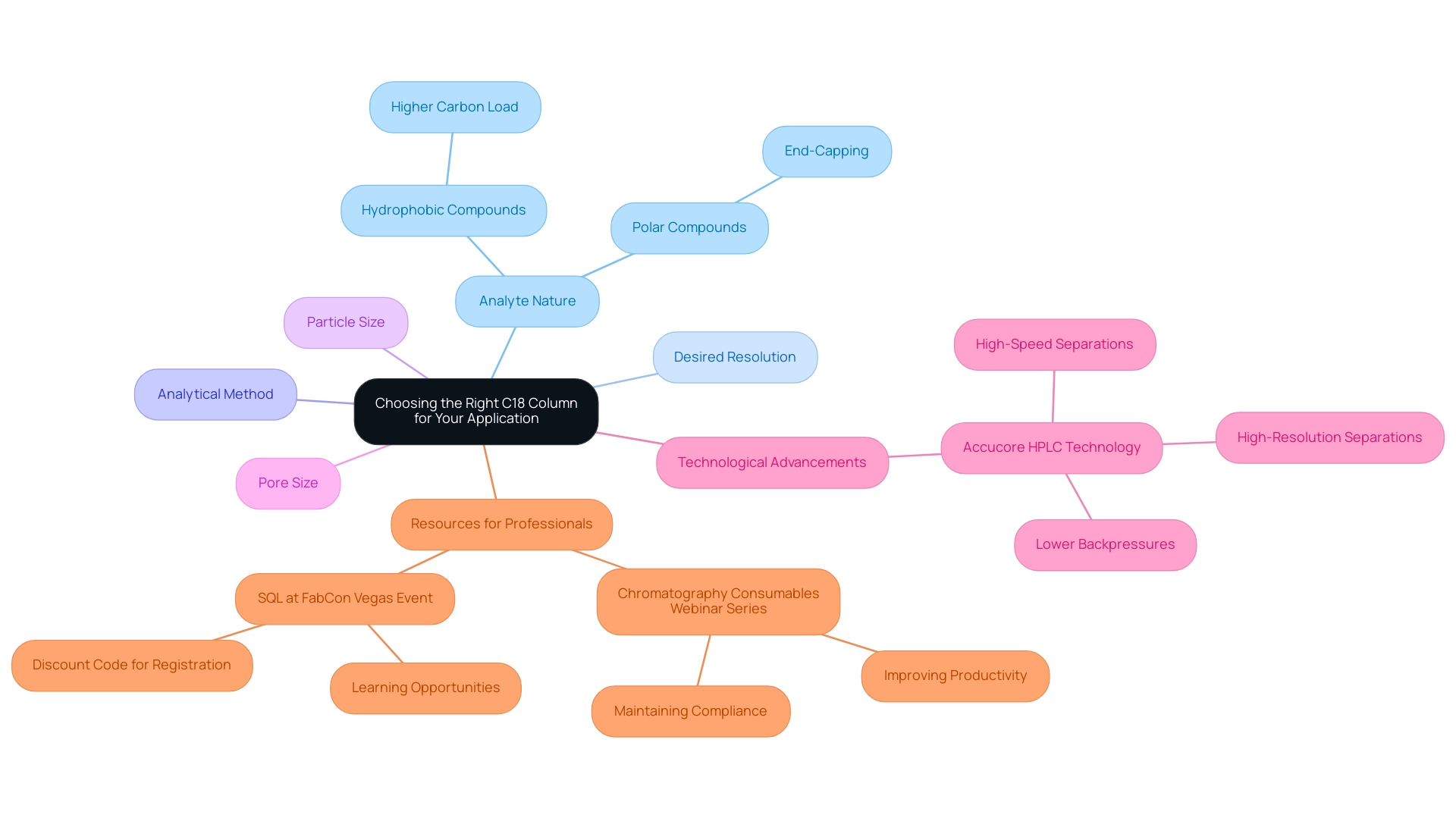Overview
The article underscores the essential role of C18 columns in laboratory chromatography, illustrating their critical importance across various applications, including:
- Pharmaceutical analysis
- Environmental monitoring
- Food chemistry
Understanding the technical specifications and best practices for maintaining C18 columns is paramount for laboratory professionals. This knowledge ensures accurate results and enhances analytical efficiency. Supported by evidence of their widespread use and advancements in technology, it is clear that mastery of these elements is crucial for achieving optimal laboratory performance.
Introduction
In the realm of analytical chemistry, C18 columns are a cornerstone, driving the effectiveness of high-performance liquid chromatography (HPLC). These octadecylsilane columns facilitate the precise separation of a vast array of compounds, from pharmaceuticals to environmental samples, due to their unique hydrophobic properties. As technology evolves, innovation surrounding C18 columns also advances, enhancing their reliability and efficiency in laboratories worldwide. Insights from industry experts and advancements in column technology reveal that understanding the nuances of C18 columns is essential for laboratory professionals seeking to optimize their analytical methodologies and ensure accurate results. This article explores the fundamentals, applications, technical specifications, and future trends of C18 columns, illuminating their pivotal role in shaping the landscape of modern chromatography.
Understanding C18 Columns: Basics and Importance
C18, commonly referred to as octadecylsilane supports, is a cornerstone of reversed-phase high-performance liquid chromatography (HPLC). These structures feature hydrophobic C18 alkyl chains attached to a silica substrate, facilitating the efficient separation of compounds based on their hydrophobic properties. Their versatility renders them indispensable in analytical chemistry, where C18 columns are employed to separate a diverse range of analytes, including pharmaceuticals, environmental samples, and food products.
The significance of C18 in analytical chemistry is profound. Recognized as the , they enhance the ability to provide consistent and reproducible results. Recent advancements in C18 technology, such as the Syncronis C18 devices, are specifically designed to maximize reproducibility and efficiency in liquid separations.
Case studies reveal that laboratories implementing these structures experience enhanced efficiency in their analytical processes, leading to more reliable outcomes. In 2025, expert opinions continue to affirm the critical role of C18 devices in chromatography. Antonino Maggio from the Istituto Superiore di Sanità emphasizes the importance of proper maintenance, advising against flushing these structures with excessive water, as it can compromise their performance. This insight highlights the necessity for laboratory professionals to grasp the intricacies of C18 maintenance and operation to ensure optimal results.
Statistically, the significance of C18 is further underscored by the extensive community of researchers on platforms like ResearchGate, which boasts over 25 million members and 160 million publication pages. Numerous discussions center on improvements specifically linked to separation techniques, reinforcing the importance of C18 supports in ongoing research and development.
Moreover, JM Science Inc. currently offers the Raptor C18, 2.7 µm, 100 x 2.1 mm HPLC Column for $869.00. This exemplifies ongoing innovation and accessibility in high-quality separation solutions, featuring enhanced performance characteristics essential for precise pharmaceutical analysis and other critical applications.
In summary, understanding the basic structure and function of C18 devices is essential for professionals in the field. Their pivotal role in enhancing analytical capabilities and ensuring accurate results makes them a vital component in the toolkit of any laboratory engaged in chromatography.

Applications of C18 Columns in Analytical Chemistry
The role of C18 materials is pivotal in a wide array of applications across diverse scientific disciplines. In pharmaceutical analysis, they are indispensable for the separation and quantification of active pharmaceutical ingredients (APIs) and their metabolites, ensuring the accuracy and reliability of drug formulations. Recent advancements highlight that the use of C18 supports has significantly improved , with regression models showing R and adjusted R values exceeding 0.9, indicating a strong fit for analytical data.
This relevance is particularly pronounced in the context of the structured approach (Doe), which enhances method development and validation in the pharmaceutical industry, ensuring regulatory compliance. Environmental scientists also utilize C18 materials to effectively analyze pollutants in water and soil samples, contributing to vital environmental monitoring efforts. In 2025, expert opinions emphasize the significance of these structures in improving the sensitivity of mass spectrometry (MS) techniques, essential for identifying trace contaminants. Additionally, C18 cartridges are utilized in food chemistry to detect additives and impurities in food items, guaranteeing consumer safety.
Clinical facilities employ C18 cartridges for the examination of biological samples, such as blood and urine, to track drug levels and metabolites, thus playing a vital role in patient care. The versatility of C18 materials is further exemplified by case studies demonstrating their application in quality control processes, where cluster analysis has been used to categorize analytes based on chromatographic behavior. This streamlines method development and enhances reproducibility in pharmaceutical manufacturing. Significantly, the case study named 'Cluster Analysis (CA) in Quality Control' has demonstrated that CA enhances the efficiency of method development by simplifying intricate separations and improving reproducibility, leading to elevated quality standards in pharmaceutical items.
The wide applicability of C18 materials makes them essential in analytical chemistry environments, with continuous innovations and research perpetually broadening their potential applications in both pharmaceutical and environmental evaluations that utilize C18. As A.M. (Abdelgawad Mohamed) noted, 'Reducing the environmental impact of drug development, as well as speeding up the time it takes to bring safe products to the market, benefits both the industry and patients, thus reshaping the future of the pharmaceutical industry.' Additionally, webinars are available to provide insights on improving MS sensitivity and strategies for efficient enantiomer separations, offering valuable resources for laboratory professionals.
The ongoing advancements in C18 technology continue to enhance its significance in various scientific fields.
Technical Specifications of C18 Columns: What You Need to Know
Choosing requires meticulous consideration of several critical technical specifications, including particle size, pore size, and carbon load for C18 applications. Typically, particle sizes for C18 materials range from 3 to 5 micrometers. Smaller particles yield higher resolution in chromatographic separations but necessitate increased pressure, which can impact the longevity of the apparatus and the overall efficiency of the analysis.
Pore sizes, which generally vary from 60 to 300 Å, significantly influence the capacity to separate larger molecules. A well-selected pore size can enhance system performance, particularly in applications involving complex mixtures or larger analytes.
The carbon load, representing the quantity of C18 bonded to the silica, is another vital specification that affects the hydrophobicity and retention characteristics of the system. A higher carbon load typically results in improved retention for non-polar compounds, making it essential for applications in pharmaceutical and environmental analysis.
Recent market trends indicate that the C18 HPLC sector is projected to expand from $1,296 million in 2025, with a compound annual growth rate (CAGR) of 7.4% until 2033. This growth is primarily driven by the pharmaceutical and biotechnology sectors, which rely on HPLC for drug discovery and quality control. Furthermore, advancements in HPLC techniques and stricter regulatory requirements are expected to further shape market dynamics.
As Manoj Phagare, Senior Research Analyst, notes, 'The strategic use of C18 supports the development of evidence-based strategies that drive success in pharmaceutical applications.'
Understanding these specifications is crucial for optimizing chromatographic methods, as they directly impact the efficiency and accuracy of analyses. As professionals in the lab navigate the complexities of separation techniques, leveraging insights into particle size and carbon load will be key to achieving reliable results. Additionally, customers can save up to 63% on quality testing products by using promo code 24138, a beneficial option for pharmaceutical lab managers seeking cost-effective solutions.

Advantages of C18 Columns: Why Choose Them?
C18 phases are highly esteemed in chromatography, recognized for their numerous advantages that make them the preferred selection for various laboratory applications involving C18. Their significant hydrophobicity enables effective separation of non-polar and moderately polar compounds, which is crucial for a wide range of analytical tasks. This versatility is further enhanced by their exceptional chemical stability, ensuring compatibility with diverse mobile phases, including both aqueous and organic solvents.
Insights from 2025 reveal that C18 not only supports reproducible results—essential for method validation and adherence to regulatory standards—but also exhibits remarkable resilience under varying conditions. Studies indicate that molecular descriptors related to structure and functional groups are particularly relevant at lower temperatures, enhancing the predictability of retention times across various applications.
As Torgny Fornstedt stated, "The authors declare that they have no known competing financial interests or personal relationships that could have appeared to influence the work reported in this paper," emphasizing the integrity of the research surrounding C18 structures.
The availability of C18 products from multiple manufacturers further aids laboratory professionals in sourcing items tailored to their specific analytical needs. Case studies have shown that the [chemical stability of C18 materials significantly bolsters the reliability of results in critical applications](https://jcheminf.biomedcentral.com/articles/10.1186/s13321-024-00873-6), such as pharmaceutical drug development, where stable salt forms of drug substances are vital for enhancing stability and bioavailability. Notably, the structure-based retention prediction method developed for ion separation can be effectively applied to C18 materials, thereby improving the accuracy of retention time forecasts for various ionic species.
Moreover, statistical data from 2025 indicates that C18 phases consistently outperform other types regarding retention time and peak width, with documenting 876 unique observations. This robust performance underscores their significance in both routine analyses and complex method development. As laboratories increasingly prioritize precision and efficiency, the advantages of C18 materials in separation techniques remain evident, reinforcing C18's status as an indispensable tool in analytical chemistry.

Challenges in Using C18 Columns: Common Issues and Solutions
C18 materials are widely recognized for their versatility and effectiveness in chromatography; however, they present notable challenges. A prevalent issue is retention loss, which may arise from inadequate conditioning of the phase or the use of highly aqueous mobile phases. Properly equilibrating the setup with the mobile phase before use is essential to mitigate this problem.
In 2025, studies indicate that retention loss continues to be a significant concern, with statistics revealing that nearly 30% of related to this phenomenon.
Another challenge faced by laboratory professionals is fouling of , often resulting from sample impurities or excessive sample loads. Implementing regular cleaning protocols, such as flushing the structure with suitable solvents, is vital for maintaining optimal performance. Monitoring pressure and retention times serves as an effective strategy for early detection of potential issues, enabling timely interventions that can avert more severe complications.
Expert advice suggests that the multiple interactions between amines and ionic liquids (ILs) within the chromatographic system should be evaluated based on the shape of chromatographic peaks rather than solely on retention changes. As noted in a recent study, "the multiple interactions that amines and ILs experience inside the chromatographic system suggest that the suppressing potency should be measured based on the shape of chromatographic peaks and not on the changes in retention." This nuanced understanding can lead to improved methods for evaluating performance and addressing retention loss.
Recent advancements in chromatography have underscored the effectiveness of fully porous silica particles (FPP) Type B structures, engineered to provide peak-tailing-free separation across various samples. These structures offer superior performance and stability, particularly advantageous for method development, especially in addressing retention loss and peak-tailing issues.
Moreover, custom HPLC units can be ordered for challenging applications, providing various particle and chemistry options that can be tailored to specific needs. This flexibility empowers laboratory professionals to better manage retention loss and fouling by selecting the most suitable vessel for their analyses.
Case studies, such as the one focusing on hierarchical clustering for similarity assessment in chromatographic data, reveal that distinct groups characterized by unique combinations of chromatographic parameters can be identified. This method enhances conditions that yield either high retention or minimal peak distortion, offering valuable insights for professionals navigating the complexities of C18 applications.
In summary, addressing the common challenges associated with C18 columns—such as retention loss and fouling—requires a combination of proper conditioning, regular maintenance, and a keen understanding of chromatographic interactions. By employing these strategies, alongside the accessibility of custom HPLC tubes and the advantages of FPP Type B tubes, professionals can enhance the reliability and precision of their analytical outcomes.
Best Practices for Maintaining C18 Columns
To maximize the longevity and performance of materials like C18, laboratory professionals must implement several key best practices. Utilizing [HPLC-grade solvents](https://jmscience.com/collections/karl-fischer-titrators?srsltid=AfmBOop-id2_Lhi1yFZQtmrdllHEaznv8uM0bKyg-GBKS327-mNy4kQ4) is paramount, as these solvents significantly influence the reliability of chromatographic results. Filtering mobile phases to remove particulates before use is essential to prevent contamination that could undermine integrity.
Regularly flushing the structure with an appropriate cleaning solvent after each use is crucial for removing any residual contaminants. This practice not only helps maintain the structure's performance but also extends its lifespan. Furthermore, storing sections in a stabilizing solvent mixture, such as acetonitrile and water, rather than pure water, is recommended to prevent degradation.
It is also vital to adhere to the manufacturer’s specified pressure limits during operation. Exceeding these limits can lead to irreversible damage to the structure, affecting both its performance and the accuracy of analytical results. By adhering to these best practices, laboratory professionals can ensure the durability of their C18 materials and maintain consistent analytical performance. This is especially significant considering that C18 biopharmaceutical drugs are anticipated to represent over 50% of newly approved medications in the near future.
Recent studies, such as the validation of for determining histamine in human immunoglobulin formulations, underscore the critical role of maintaining high-quality chromatography in biopharmaceutical applications. The validated method demonstrated high accuracy and precision, confirming its utility in controlling histamine levels in biopharmaceutical products. This emphasizes the significance of utilizing HPLC-grade solvents, as they directly influence performance and the reliability of analytical results.
As John W. Dolan noted, "Computer simulation is a powerful tool for ," emphasizing the need for maintaining optimal conditions for the C18 columns. Additionally, size-exclusion techniques (SEC) are commonly utilized for analyzing protein therapeutics, further illustrating the broader applications of these methods in the pharmaceutical industry. Recent advancements, such as the use of DIA-NN (v1.7.15) for data analysis, also highlight the evolving landscape of chromatography practices, making it essential for laboratory professionals to stay informed and adapt their methodologies accordingly.
Choosing the Right C18 Column for Your Application
Selecting the appropriate C18 medium for a specific application requires a nuanced understanding of several critical factors. These include the nature of the analytes, the desired resolution, and employed with C18. For instance, when dealing with highly hydrophobic compounds, opting for a C18 material with a higher carbon load can significantly enhance separation efficiency. Conversely, for polar compounds, utilizing a C18 phase with end-capping can mitigate unwanted interactions, improving peak shape and overall resolution.
Furthermore, the choice of particle size and pore size is crucial; these dimensions should be tailored to the molecular weight of the analytes to facilitate optimal separation. Recent insights from industry experts, such as Dafydd Milton, underscore that advancements in C18 technology, including the new Accucore HPLC technology, enable high-speed and high-resolution separations while maintaining manageable backpressures.
Case studies from the Chromatography Consumables Webinar Series illustrate the practical implications of these selection criteria. Participants have reported enhanced productivity and compliance in their workspaces by applying these principles to their chromatographic methods. These webinars serve as a valuable resource for laboratory professionals aiming to stay informed on progress in chromatography.
By carefully evaluating these elements and utilizing resources such as the Chromatography Consumables Webinar Series, laboratory professionals can make informed decisions, ensuring they select the most suitable C18 device for their analytical requirements in 2025. Additionally, the upcoming SQL at FabCon Vegas event from March 31 to April 2 presents an exceptional opportunity for professionals in the field to explore the latest innovations in separation science and related technologies. JM Science's dedication to updating product offerings and fostering strong relationships with manufacturers further supports the evolving needs of the scientific community.

Future Trends in C18 Column Technology: What to Expect
The future of c18 technology is set for remarkable advancements, propelled by ongoing research and development in chromatography. A particularly promising innovation is the use of superficially porous particles (SPPs), which significantly enhance mass transfer efficiency. This enhancement facilitates quicker and more effective separations, a crucial element for facilities aiming to increase throughput without compromising precision.
Additionally, the introduction of novel bonding chemistries and materials is expected to improve the stability and selectivity of C18 structures. These advancements will empower laboratories to achieve superior performance, especially when addressing challenging analytes that necessitate precise separation techniques. As the industry transitions towards greener practices, there is an increasing focus on sustainable column technologies that minimize solvent consumption and reduce waste, aligning with the principles of green chemistry.
The separation instruments market is projected to experience significant growth from 2020 to 2025, particularly in the Asia Pacific region, where environmental initiatives and government support for the pharmaceutical sector are driving demand. A case study titled "Asia Pacific Market Potential for Analytical Instruments" illustrates that the COVID-19 pandemic has further accelerated research and development activities, resulting in increased investments in drug discovery and a heightened need for advanced analytical solutions.
Staying informed about these trends is essential for professionals seeking to optimize their analytical capabilities. As Randy emphasizes, the role of leadership in fostering innovations in chromatography is critical for adapting to these changes. By embracing advancements in , laboratories can enhance their operational efficiency and contribute to the progress of research and healthcare.
Conclusion
C18 columns remain a cornerstone of the analytical chemistry landscape, serving as an essential tool in high-performance liquid chromatography (HPLC). Their distinctive hydrophobic properties facilitate the precise separation of a diverse array of compounds, rendering them invaluable across various applications, from pharmaceuticals to environmental analysis. Recent advancements in C18 column technology, particularly in reproducibility and efficiency, highlight their enduring significance in contemporary laboratories.
Laboratory professionals must acknowledge the critical importance of selecting and maintaining C18 columns to achieve optimal performance. A thorough understanding of key specifications—such as particle size, pore size, and carbon load—is vital for customizing columns to meet specific analytical requirements. Challenges like retention loss and column fouling can be effectively mitigated through established best practices, thereby enhancing the reliability of analytical results.
As chromatography continues to evolve, the future of C18 column technology heralds promising innovations. Developments such as superficially porous particles and sustainable practices exemplify the industry's dedication to enhancing efficiency while minimizing environmental impact. By remaining informed about these trends and leveraging technological advancements, laboratory professionals can refine their methodologies, ultimately leading to more accurate and reliable analytical outcomes. Embracing the potential of C18 columns not only boosts laboratory productivity but also aligns with the broader objectives of research and healthcare in an ever-evolving scientific landscape.




